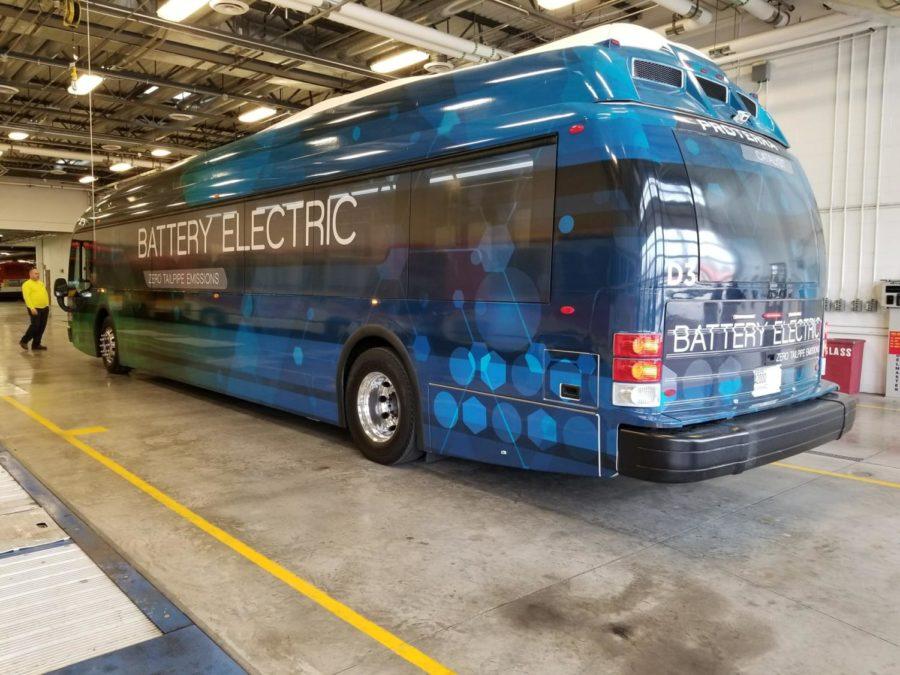Proterra presents electric bus to CyRide
Christian Simmons/Iowa State Daily
20171026_100422.jpg
November 15, 2017
Electric cars have been popping up around the country. Tesla, BMW, Ford, Nissan and Toyota have been household names for electric cars for years now.
Ryan Saunders, a senior in mechanical engineering, is hoping to bring electric buses to Ames. His independent study, which began in August, is working to have fully electric buses adopted by CyRide.
Saunders loves the idea of sustainability and environmentally friendly vehicles. The electric bus technology is something he admires.
As a student, Saunders experiences firsthand what is disliked about the current CyRide diesel buses. He mentions the noise, safety and the emissions that make Union Drive “smell like a diesel alleyway.”
The noise and emission benefits are easy to understand, but safety benefits might be less obvious.
According to the Federal Motor Carrier Safety Administration, in 2015, 6,159 buses or large trucks were involved in overturns causing fatalities, injuries or property damage.
Proterra, Inc., a bus manufacturer Saunders has been researching extensively solves this problem with their bus design.
As the only bus manufacturer that makes new electric buses from the ground up, Proterra creates their buses with the battery cells under the bus, creating a lowered center of mass.
Proterra also said their buses are made with a lightweight, albeit strong, composite material that will protect passengers on the bus in case of a collision. This composite is, in some cases, stronger than the steel used on buses in CyRide’s fleet today.
A large concern CyRide has is making sure they are comfortable with the performance of buses on the road. There have been many challenges CyRide has faced with the current Cybrid buses, which run on a form of cooking oil. Proterra recently brought an electric bus from their South Carolina plant to present to CyRide.
The bus features the same physical stats, 40 feet long with the same number of seats, while boasting a quieter engine and much lower cost over the life of the bus. The interior is almost identical to the current diesel buses, with an added television monitor mounted at the front of the bus behind the driver. The bus also rides similar to a diesel bus, while of course being quieter and not having a lingering smell of fuel emission.
Lauren Cochran, a sales representative from Proterra who demoed the bus for CyRide at their maintenance center, said that it is “just a matter of time” before CyRide transitions completely to electric buses.
Cochran plans to come back and provide CyRide with a cost analysis, giving CyRide an estimated cost per year based on the routes’ grade, length, stops and average speed and acceleration.
This cost analysis is going to be done by Cochran and an organization called Center for Transportation and the Environment (CTE). CTE is a third party, independent organization that provides assistance to bus companies wanting to provide their community with more environmentally friendly bus services.
Saunders has another presentation, this time in front of the CyRide board, to further explain the benefits and what it would cost for the project to succeed. His goal is to get a commitment from CyRide to do their own research on electric buses and decide if the switch is worth it.
Sheri Kyras, director of transit at CyRide, explained that money is the largest hurdle.
CyRide currently operates 95 buses. The maximum cost of $800,000 to purchase each electric bus multiplied by 95 buses totals $76 million.
With a yearly budget of around $10.5 to $11 million, this is obviously not feasible for quite a few years. This doesn’t even take into account the new infrastructure the CyRide facility would need to maintain and charge these electric buses.
Dale Hill, founder of Proterra, said CyRide could save around $300,000 per bus for its lifetime, potentially offsetting the initial cost of the electric buses over time.
To help pay for the buses, there are federal grants such as the Low-No grant. This grant is allocated $55 million per year and is split between any organizations that are awarded grant money.
Kyras also mentioned that Low-No grants are very competitive, but definitely something CyRide wants to pursue. Fortunately, CTE is also prepared to help CyRide create a grant application.
Another important hurdle for CyRide is making sure the student body supports the switch.
Kyras said currently about $5 million of the about $11 million budget is from student fees. That works out to about $76 per student per semester.
Raising this fee would require support from student government, students on the CyRide board, representatives from the university and the board of regents, who have to support every tuition fee.
Kyras said the technology for electric buses has only recently become feasible. Before, electric buses in cities needed charging ports around the city in order to last an entire shift, something that was simply not possible for CyRide to achieve in the past.
While training is not an additional cost, it is included in the price of the bus, there are unforeseen additional costs that could lead to trouble down the road.
“The technology has now progressed to the point where it could be feasible, so now we’re just starting the process,” Kyras said. “We don’t know a lot of the answers, and we probably don’t know all of the questions at this point.”







